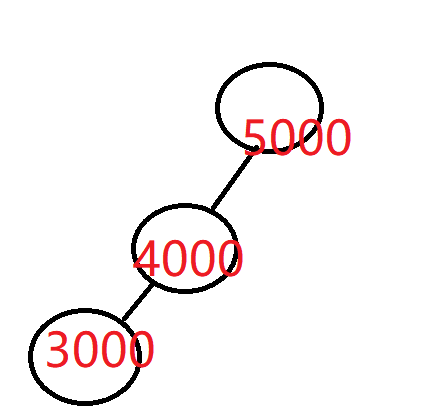返回目录
题目描述:
定义构造三叉搜索树规则如下:
每个节点都存有一个数,当插入一个新的数时,从根节点向下寻找,直到找到一个合适的空节点插入。
查找的规则是:
- 如果数小于节点的数减去500,则将数插入节点的左子树
- 如果数大于节点的数加上500,则将数插入节点的右子树
- 否则,将数插入节点的中子树
给你一系列数,请按以上规则,按顺序将数插入树中,构建出一棵三叉搜索树,最后输出树的高度。
输入描述:
第一行为一个数N,表示有N个数,1<=N<=10000
第二行为N个空格分隔的整数,每个数的范围为[1,10000]
输出描述:
输出树的高度(根节点的高度为1)
示例:
| 输入 | 3 5000 4000 3000 |
|---|---|
| 输出 | 3 |
| 说 明 |  |
题目解析
本题应该只是需要模拟出三叉树结构,以及根据指定的逻辑进行插入新节点。
三叉树节点的数据结构定义如下:
{
val, // 节点值
height,// 节点所在高度,
left,// 左子树根节点,
right,// 右子树根节点,
mid,// 中子树根节点
}
三叉树的数据结构定义如下:
{
root,// 根节点
height,// 树的高度
}
Python算法源码
class TreeNode:
def __init__(self, val):
self.val = val
self.height = -1 # 初始化高度为 -1,表示未分配的节点
self.left = None
self.mid = None
self.right = None
class Tree:
def __init__(self):
self.root = None # 根节点
self.height = 0 # 树的高度
# 添加节点到树中
def add(self, val):
node = TreeNode(val) # 创建新节点
# 如果根节点为空,则将新节点设为根节点
if self.root is None:
node.height = 1 # 新节点高度设为 1
self.root = node
self.height = 1 # 树高度设为 1
else:
cur = self.root
# 遍历树找到合适的位置插入新节点
while True:
node.height = cur.height + 1 # 更新新节点高度
self.height = max(node.height, self.height) # 更新树的高度
# 如果新节点值比当前节点值小 500 以上,则插入当前节点的左子树
if val < cur.val - 500:
# 如果当前节点的左子节点为空,则将新节点设为左子节点,否则继续向左子树遍历
if cur.left is None:
cur.left = node
break
else:
cur = cur.left
# 如果新节点值比当前节点值大 500 以上,则插入当前节点的右子树
elif val > cur.val + 500:
# 如果当前节点的右子节点为空,则将新节点设为右子节点,否则继续向右子树遍历
if cur.right is None:
cur.right = node
break
else:
cur = cur.right
# 否则插入当前节点的中间子树
else:
# 如果当前节点的中间子节点为空,则将新节点设为中间子节点,否则继续向中间子树遍历
if cur.mid is None:
cur.mid = node
break
else:
cur = cur.mid
if __name__ == "__main__":
while True:
try:
n = int(input()) # 读取整数 n
nums = list(map(int, input().split())) # 读取一C算法源码
#include <stdio.h>
#include <stdlib.h>
// 定义树节点结构体
typedef struct TreeNode {
int val; // 节点值
int height; // 节点高度
struct TreeNode *left, *mid, *right; // 左、中、右子节点
} TreeNode;
// 定义树结构体
typedef struct Tree {
TreeNode *root; // 根节点
int height; // 树的高度
} Tree;
// 创建树节点
TreeNode* createTreeNode(int val) {
TreeNode *node = (TreeNode*)malloc(sizeof(TreeNode)); // 分配内存空间
if (node != NULL) {
node->val = val;
node->height = -1; // 初始化高度为 -1,表示未分配的节点
node->left = node->mid = node->right = NULL; // 初始化子节点为 NULL
}
return node;
}
// 初始化树
Tree* createTree() {
Tree *tree = (Tree*)malloc(sizeof(Tree)); // 分配内存空间
if (tree != NULL) {
tree->root = NULL;
tree->height = 0;
}
return tree;
}
// 添加节点到树中
void addNode(Tree *tree, int val) {
TreeNode *node = createTreeNode(val); // 创建新节点
// 如果根节点为空,则将新节点设为根节点
if (tree->root == NULL) {
node->height = 1; // 新节点高度设为 1
tree->root = node;
tree->height = 1; // 树高度设为 1
} else {
TreeNode *cur = tree->root;
// 遍历树找到合适的位置插入新节点
while (1) {
node->height = cur->height + 1; // 更新新节点高度
tree->height = (node->height > tree->height) ? node->height : tree->height; // 更新树的高度
// 如果新节点值比当前节点值小 500 以上,则插入当前节点的左子树
if (val < cur->val - 500) {
// 如果当前节点的左子节点为空,则将新节点设为左子节点,否则继续向左子树遍历
if (cur->left == NULL) {
cur->left = node;
break;
} else {
cur = cur->left;
}
}
// 如果新节点值比当前节点值大 500 以上,则插入当前节点的右子树
else if (val > cur->val + 500) {
// 如果当前节点的右子节点为空,则将新节点设为右子节点,否则继续向右子树遍历
if (cur->right == NULL) {
cur->right = node;
break;
} else {
cur = cur->right;
}
}
// 否则插入当前节点的中间子树
else {
// 如果当前节点的中间子节点为空,则将新节点设为中间子节点,否则继续向中间子树遍历
if (cur->mid == NULL) {
cur->mid = node;
break;
} else {
cur = cur->mid;
}
}
}
}
}
int main() {
while (1) {
int n;
if (scanf("%d", &n) != 1)
break;
int val;
Tree *tree = createTree(); // 创建树对象
// 将整数值添加到树中
for (int i = 0; i < n; i++) {
scanf("%d", &val);
addNode(tree, val);
}
printf("%d\n", tree->height); // 输出树的高度
}
return 0;
}Java算法源码
import java.util.Scanner;
// 定义树节点类
class TreeNode {
int val; // 节点值
int height; // 节点高度
TreeNode left, mid, right; // 左、中、右子节点
// 构造函数,初始化节点值和高度,子节点初始化为 null
public TreeNode(int val) {
this.val = val;
this.height = -1; // 初始化高度为 -1,表示未分配的节点
this.left = this.mid = this.right = null;
}
}
// 定义树类
class Tree {
TreeNode root; // 根节点
int height; // 树的高度
// 构造函数,初始化根节点为 null,高度为 0
public Tree() {
this.root = null;
this.height = 0;
}
// 添加节点到树中
public void add(int val) {
TreeNode node = new TreeNode(val); // 创建新节点
// 如果根节点为空,则将新节点设为根节点
if (root == null) {
node.height = 1; // 新节点高度设为 1
root = node;
height = 1; // 树高度设为 1
} else {
TreeNode cur = root;
// 遍历树找到合适的位置插入新节点
while (true) {
node.height = cur.height + 1; // 更新新节点高度
height = Math.max(node.height, height); // 更新树的高度
// 如果新节点值比当前节点值小 500 以上,则插入当前节点的左子树
if (val < cur.val - 500) {
// 如果当前节点的左子节点为空,则将新节点设为左子节点,否则继续向左子树遍历
if (cur.left == null) {
cur.left = node;
break;
} else {
cur = cur.left;
}
}
// 如果新节点值比当前节点值大 500 以上,则插入当前节点的右子树
else if (val > cur.val + 500) {
// 如果当前节点的右子节点为空,则将新节点设为右子节点,否则继续向右子树遍历
if (cur.right == null) {
cur.right = node;
break;
} else {
cur = cur.right;
}
}
// 否则插入当前节点的中间子树
else {
// 如果当前节点的中间子节点为空,则将新节点设为中间子节点,否则继续向中间子树遍历
if (cur.mid == null) {
cur.mid = node;
break;
} else {
cur = cur.mid;
}
}
}
}
}
}
// 主类
public class Main {
public static void main(String[] args) {
Scanner scanner = new Scanner(System.in);
// 无限循环,直到捕获到异常结束程序
while (true) {
try {
int n = Integer.parseInt(scanner.nextLine()); // 读取整数 n
String[] nums = scanner.nextLine().split(" "); // 读取一系列整数值并以空格分隔
Tree tree = new Tree(); // 创建树对象
// 将整数值添加到树中
for (String num : nums) {
tree.add(Integer.parseInt(num));
}
System.out.println(tree.height); // 输出树的高度
} catch (Exception e) {
break; // 捕获异常时结束循环
}
}
}
}
7 条评论
class Tree():
def __init__(self,root, left=None, right=None,middle=None):
self.root = root
self.left = left
self.right = right
self.middle = middle
def inset(self, num):
if num < self.root - 500:
if not self.left:
self.left = Tree(num)
else:
self.left.inset(num)
elif num > self.root + 500:
if not self.right:
self.right = Tree(num)
else:
self.left.inset(num)
else:
if not self.middle :
self.middle = Tree(num)
else:
self.left.inset(num)
def get_height(self):
if self.left:
left_height = self.left.get_height()
else:
left_height = 0
if self.right:
right_height = self.right.get_height()
else:
right_height = 0
if self.middle:
middle_height = self.middle.get_height()
else:
middle_height = 0
return max(left_height,right_height,middle_height) + 1
def main():
N = int(input())
nums = list(map(int, input().split()))[:N]
root = Tree(nums[0])
for i in nums[1:]:
root.inset(i)
print(root.get_height())
if __name__ == '__main__':
main()
点赞
[...]2024 C卷 100分序号题目知 识 点难易程度1密码输入检测数据结构/栈☆☆☆2分配土地几何问题☆☆☆3找座位逻辑分析☆☆☆4智能成绩表动态条件分析☆☆☆5内存冷热标记多条件排序☆☆☆6螺旋数字矩阵逻辑分析☆☆☆7围棋的气逻辑分析☆☆☆8分割平衡字符串逻辑分析☆☆☆9机器人搬砖二分法☆☆☆10转盘寿司数据结构/栈/单调栈☆☆☆11小明找位置二分法☆☆☆12提取字符串的最长合法简单数学表达式双指[...]
[...]2024 C卷 100分序号题目知 识 点难易程度1密码输入检测数据结构/栈☆☆☆2分配土地几何问题☆☆☆3找座位逻辑分析☆☆☆4智能成绩表动态条件分析☆☆☆5内存冷热标记多条件排序☆☆☆6螺旋数字矩阵逻辑分析☆☆☆7围棋的气逻辑分析☆☆☆8分割平衡字符串逻辑分析☆☆☆9机器人搬砖二分法☆☆☆10转盘寿司数据结构/栈/单调栈☆☆☆11小明找位置二分法☆☆☆12提取字符串的最长合法简单数学表达式双指[...]
[...]2024 C卷 100分序号题目知 识 点难易程度1密码输入检测数据结构/栈☆☆☆2分配土地几何问题☆☆☆3找座位逻辑分析☆☆☆4智能成绩表动态条件分析☆☆☆5内存冷热标记多条件排序☆☆☆6螺旋数字矩阵逻辑分析☆☆☆7围棋的气逻辑分析☆☆☆8分割平衡字符串逻辑分析☆☆☆9机器人搬砖二分法☆☆☆10转盘寿司数据结构/栈/单调栈☆☆☆11小明找位置二分法☆☆☆12提取字符串的最长合法简单数学表达式双指[...]
[...]2024 C卷 100分序号题目知 识 点难易程度1密码输入检测数据结构/栈☆☆☆2分配土地几何问题☆☆☆3找座位逻辑分析☆☆☆4智能成绩表动态条件分析☆☆☆5内存冷热标记多条件排序☆☆☆6螺旋数字矩阵逻辑分析☆☆☆7围棋的气逻辑分析☆☆☆8分割平衡字符串逻辑分析☆☆☆9机器人搬砖二分法☆☆☆10转盘寿司数据结构/栈/单调栈☆☆☆11小明找位置二分法☆☆☆12提取字符串的最长合法简单数学表达式双指[...]
[...]真题目录序号题目知 识 点难易程度1密码输入检测数据结构/栈☆☆☆2分配土地几何问题☆☆☆3找座位逻辑分析☆☆☆4智能成绩表动态条件分析☆☆☆5内存冷热标记多条件排序☆☆☆6螺旋数字矩阵逻辑分析☆☆☆ 围棋的气逻辑分析☆☆☆ 分割平衡字符串逻辑分析☆☆☆ 机器人搬砖二分法☆☆☆ 转盘寿司数据结构/栈/单调栈☆☆☆ 小明找位置二分法☆☆☆ 提取字符串的最长合法简单数学表达式双指针☆☆☆☆ 掌握的单词[...]